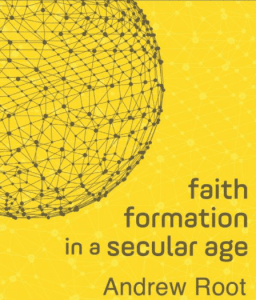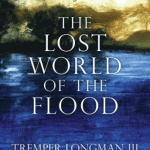 In Andrew Root’s Faith Formation in a Secular Age, Root sketches three kinds of Secular:
In Andrew Root’s Faith Formation in a Secular Age, Root sketches three kinds of Secular:
Secular 1: Sacred versus Secular Planes
Secular 2: Religious versus A-religious Spaces
Secular 3: The Negating of Transcendence
What happens to faith in Secular 2 and 3? Faith in Secular 2 is joining and participating in an organization, an institution, a church. Formation then becomes about attendance and participation. Secular 2 and 3 are not the same and faith and faith formation in each is different. What are the elements of faith in Secular 3? Two elements are necessary: experience and personhood. Faith is about “union with Christ,” but union is not the erasure of personality into infinity or divinity. It is hypostatic in the sense of the union of two persons into a permeating union that leaves each viable. Experience and personhood are at the heart of this union with Christ. Faith formation then in Secular 3, our world, is abut these elements of experience and personhood with the real Christ.
But what about faith formation? Root begins with the weakness of Secular 2:
Faith formation becomes a process that wins religious commitment, and faith itself is the process’s end. Faith is to make a legitimate commitment to the religious space through sociologically defined categories like institutional participation and asserted beliefs. We then hone our processes to meet this end; faith formation becomes little more than getting people to stay in church and believe what they were taught. Allowing faith formation to be disconnected from the shape of divine action means any attention to the process and object of faith is ruled out. A real ontic union (a connection of being with being) with Christ is lost (in no small part because sociologists have no instrument to measure this and, in the anxiety of Secular 2 and hidden pulls of Secular 3, only the immanent-frame-bound sociologist can define faith and its formations).”
This is where the issue for Andrew Root is: if faith is union with Christ, and the means union with the story of Christ, we need to understand the story of Christ to know what faith and faith formation is.
The process of formation for Paul can take the form of divine action only because it is the real ontic union with the being of Jesus himself. To have faith is to be in Christ; it is to have the faith of Christ because Christ lives in you.
At the heart of Root’s project is the work of Michael Gorman and in particular his theory of cruciformity. What is cruciformity if it is not the surrendering of Christ to death in order to redeem? Which means, cruciformity is ministry to and for others. Which means, the spiritually formed person is the one who forms personhood relations with others for the sake of redemption. (More of this below.)
Now some statements:
But what substantiates this death experience as a union in the person of Jesus is that divine action enters death as ministry. When Paul is ministered to, in and through his death experience he is taken from cross to resurrection, he is swept up into participation in the ontic union of the Trinity, giving a new narrative arc to his very being. The Trinity has its being in and through the rationality of ministry. The Father ministers to the Son through the Spirit, as the Son ministers to the Father. The perichoresis of the Trinity is more than just a simple dance (as it is too often defined) but is instead the deepest form of presence and sharing.
Root examines – in Gorman fashion — Philippians 2:6-11 as the core of Paul’s theology and vision of the Christian life. That hymn has a three step act that reveals who God is and what it means to enter into the story of God or the story of Jesus. Because he was X he did not do Y but instead did Z. That in a nutshell is cruciformity: it is not to do what we can because of who we are but instead to do what is redemptive for the other. Formation and ministry belong together: to be formed in faith is to become a minister to others.
Paul recognizes that the state of Jesus’s own being is kenotic, self-emptying. It is kenosis that allows for the sharing of hypostasis (sharing in personhood). Being can be shared when it is wrapped in kenosis; the divine and human nature can share in Jesus’s person because Jesus has humbled himself, not to be a doormat but to be a minister.
This catchy chorus of “although [x] not [y] but [z]”28 (“although/because [x] he was in the form of God, he did not count equality with God a thing to be grasped [y], but emptied himself, taking the form of a servant, being born in the likeness of [humanity] [z]”) becomes the narrative shape of ministry that is cruciform. Because God’s being is found in God’s story of cross and resurrection, those formed in faith must take on this story as well. Faith formation is performing the “although [x] not [y] but [z]” narrative by being a minister. The process of faith formation is to allow this kenotic chorus “although [x] not [y] but [z]” to structure your life, calling you to be a minister in the world.
“Although [x] not [y] but [z]” is no do-goodism; it has no ambition through human action to change the world for good or for God. It has no ambition to meet a goal that would swallow the personhood of another. Rather, “although [x] not [y] but [z]” is only the moving chorus that invites us to enter the death experiences of the persons around us, to share in their very being by humbling ourselves to experience their personhood. “Although [x] not [y] but [z]” is only the song of prelude sung as the preparatory liturgy that takes us into the personhood of our neighbor, to participate in their death experience (the cross) as minister. Faith is formed, then, not through upping the commitment level by adding adjectives so we might win some space in Secular 2; rather, faith is formed through singing the “although [x] not [y] but [z].” It is in doing this that the “although” is revealed to be “because.” The kenotic then leads us into the hypostatic, giving us a union with the divine being and an experience of the transcendent.
So, MTD (moral, therapeutic deism) is what faith looks like today; it needs to become HKT: hypostatic union with others through ministry, kenotic in denying ourselves, and theosis in being made into the image of God in Christ and his cross.
















